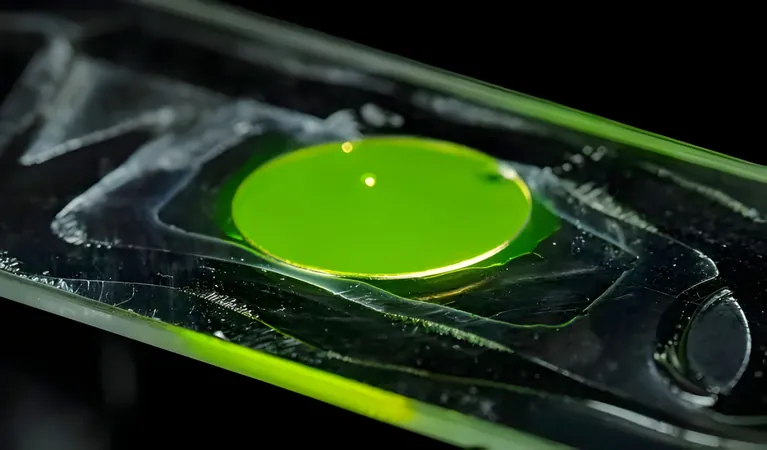
Revolutionary 'Living Lenses' Created from Bacteria: A Peek Inside Cells!
2025-04-13
Author: Wei
Nature's Wonders: Inspired Innovations
Scientists have long marveled at the remarkable glass-like skeletons built by sea sponges—structures that defy their fragile appearance with surprising strength. Now, this marine marvel has sparked a groundbreaking scientific endeavor: the creation of tiny, durable lenses using bacteria.
Meet the Brain Behind the Breakthrough
Leading this innovative research is Anne S. Meyer, an associate professor at the University of Rochester's Department of Biology. Her team's focus on sponge-derived enzymes turned out to have vast implications for tech.
A Bright Idea: Bacteria Turned Lens Makers
Meyer and her collaborators implemented a unique method, mixing sponge enzymes with specific bacteria. This clever combination allowed living bacterial cells to craft themselves into minuscule lenses, termed microlens devices. These lend themselves to a range of applications, particularly in medical imaging and commercial technologies.
Collaboration Across Continents
In partnership with scientific teams from the University of Colorado Boulder, Delft University of Technology, and Leiden University, the research represents a remarkable fusion of biology and optics. Together, they engineered living cells that can form a glass-like shell under normal conditions—no fancy labs required!
Sponge Power: How It Works
By introducing the enzyme silicatein into the outer layers of bacterial cells, Meyer's team facilitated the gathering of silica-based material, creating a robust coating. This innovation enables the bacteria to focus incoming light into concentrated beams while maintaining their vitality for months on end.
Medical Imaging's New Frontier
These bacterial lenses pack a punch. Their microscopic size could revolutionize imaging techniques, allowing scientists to uncover details hidden in tissue samples. The potential spans from advanced medical imaging to high-resolution inspection tools in manufacturing.
Affordable Innovation: The Future of Microlenses
What sets these living lenses apart is not only their efficacy but also their resilience. Unlike traditional microlens production methods that are costly and energy-intensive, these lenses can be manufactured in straightforward conditions. This makes them more accessible and easy to reproduce, showcasing their practicality.
Innovation on the Horizon
The potential for these living lenses is vast. Imagine integrating them into image sensors to enhance resolution or embedding them in flexible materials for wearable tech. The concept of self-repairing or adaptive optical elements opens doors to untold possibilities.
Tiny Detectives for Tough Environments
Thanks to their survival capabilities, these microscopic lenses could serve as sensitive detectors in various environments, including tough or inaccessible locations. Meyer has expressed interest in exploring their application in extraterrestrial settings, where sophisticated fabrication tools are unavailable.
Challenges Ahead: A Bright Future?
Despite the excitement surrounding these living lenses, researchers are still working to understand how they will perform in real-world applications. Questions remain regarding their reliability in sensitive fields like medicine and aerospace, and scaling production for commercial use poses significant challenges.
Conclusion: A New Era of Optics
With the findings published in the Proceedings of the National Academy of Sciences, the research could usher in a new era of optical devices. As we unlock the full potential of these living lenses, the future of imaging could be both more advanced and astonishing.

 Brasil (PT)
Brasil (PT)
 Canada (EN)
Canada (EN)
 Chile (ES)
Chile (ES)
 Česko (CS)
Česko (CS)
 대한민국 (KO)
대한민국 (KO)
 España (ES)
España (ES)
 France (FR)
France (FR)
 Hong Kong (EN)
Hong Kong (EN)
 Italia (IT)
Italia (IT)
 日本 (JA)
日本 (JA)
 Magyarország (HU)
Magyarország (HU)
 Norge (NO)
Norge (NO)
 Polska (PL)
Polska (PL)
 Schweiz (DE)
Schweiz (DE)
 Singapore (EN)
Singapore (EN)
 Sverige (SV)
Sverige (SV)
 Suomi (FI)
Suomi (FI)
 Türkiye (TR)
Türkiye (TR)
 الإمارات العربية المتحدة (AR)
الإمارات العربية المتحدة (AR)